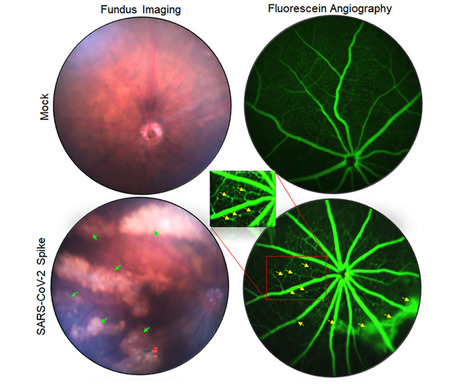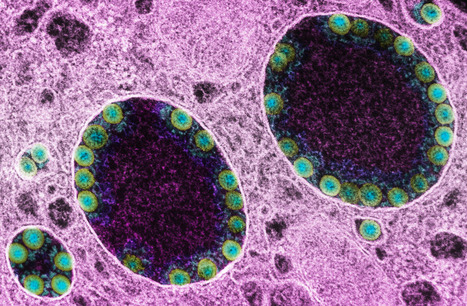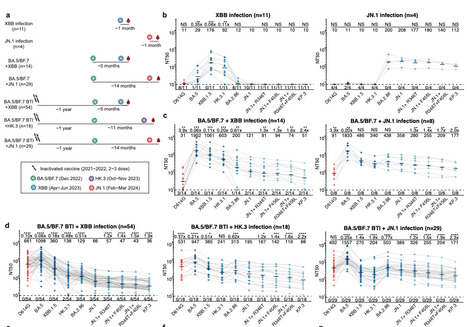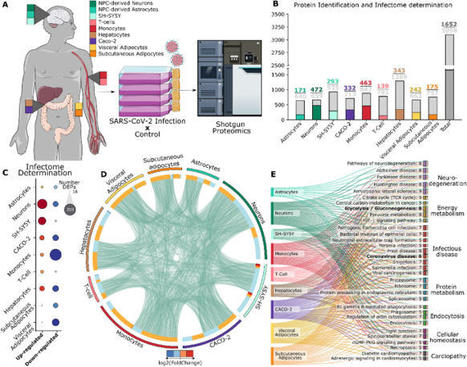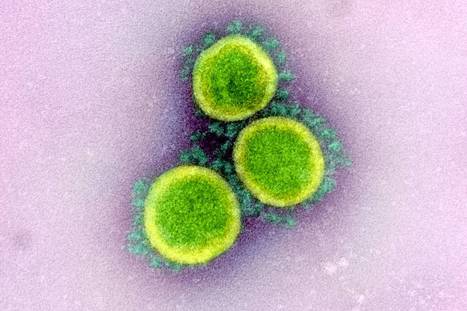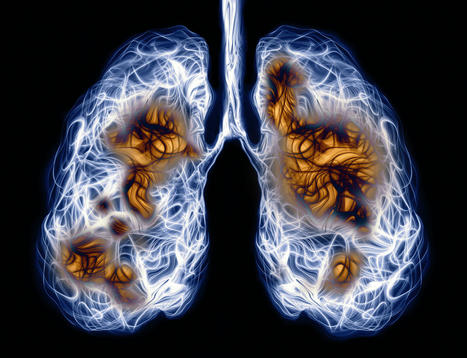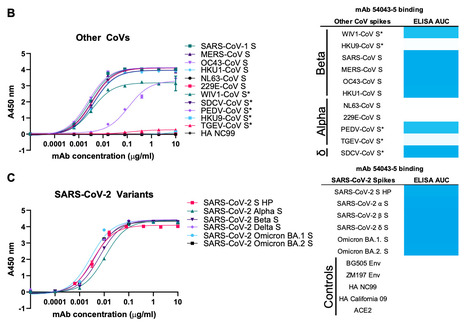 Your new post is loading...

|
Scooped by
Juan Lama
|
Common diabetes drug lowers SARS-CoV-2 levels, clinical trial finds Stephanie Soucheray, MA COVID-19 Thinglass/iStock Share Today, researchers from the University of Minnesota published evidence that the common diabetes drug metformin decreases the amount of SARS-CoV-2 in the body and helps reduce the risk of rebound symptoms if given early in the course of non-severe illness. The study, published in Clinical Infectious Diseases, suggests metformin may also help prevent long COVID. The researchers tested metformin against a placebo in 999 adults infected with COVID-19. More than 50% of the study enrollees were vaccinated, and treatment took place when the Omicron variant was the most dominant strain in the United States. Study included those at standard-risk. Moreover, according to Carolyn Bramante, MD, principal investigator of the study and an assistant professor at the University of Minnesota, the study participants represented a standard- risk population, a group that currently lacks effective treatment options for the novel coronavirus. "This is not a high-risk population," Bramante told CIDRAP News. Instead, participants were 30 years or older, had a body mass index of 25 or higher (overweight), and did not require hospitalization for their COVID-19 infection. In several trials, Paxlovid has been shown to prevent deaths and hospitalization in high-risk, unvaccinated people, but standard-risk populations have not shown improvement in either time to resolution of symptoms or the incidence of hospitalization or death. Bramante said that these patient population demographics suggest metformin may be a clinical tool in outpatient medication that could be widely used. "The data support that someone would be justified if they prescribed it for outpatient treatment," she said. Four-fold reduction in viral load by day 10. Participants were given a 14-day course of metformin, and participants collected nasal swabs on days 1, 5, and 10. Bramante said early treatment was key: Participants were enrolled within 3 days of a positive test, and if symptomatic, reported having symptoms for 7 or fewer days. The mean SARS-CoV-2 viral load was reduced 3.6-fold with metformin relative to placebo by day 10, the authors found, and those who received metformin were less likely to have a detectable viral load than placebo at days 5 or 10 (odds ratio [OR], 0.72; 95% confidence interval [CI], 0.55 to 0.94). Metformin reduced the odds of hospitalization or death through 28 days by 58%; emergency department visits, hospitalizations, and death through 14 days by 42%; and long COVID through 10 months by 42%. Viral rebound, defined as a higher viral load at day 10 than day 5, was less frequent with metformin (3.28%) than placebo (5.95%; OR, 0.68; 95% CI, 0.36 to 1.29). While the mechanism of action is not known, Bramante said metformin likely lowers inflammation and inhibits translation of the virus. In a commentary on the study, the authors write, "This study makes a strong case for a potential effect of metformin on COVID-19 virologic decay and prompts reevaluation of existing data in support of its use. Research cited published (May 1, 2024) in Clin. Infect. Dis.: https://doi.org/10.1093/cid/ciae159

|
Scooped by
Juan Lama
|
An improved understanding of the underlying physicochemical properties of respiratory aerosol that influence viral infectivity may open new avenues to mitigate the transmission of respiratory diseases such as COVID-19. Previous studies have shown that an increase in the pH of respiratory aerosols following generation due to changes in the gas-particle partitioning of pH buffering bicarbonate ions and carbon dioxide is a significant factor in reducing SARS-CoV-2 infectivity. We show here that a significant increase in SARS-CoV-2 aerostability results from a moderate increase in the atmospheric carbon dioxide concentration (e.g. 800 ppm), an effect that is more marked than that observed for changes in relative humidity. We model the likelihood of COVID-19 transmission on the ambient concentration of CO2, concluding that even this moderate increase in CO2 concentration results in a significant increase in overall risk. These observations confirm the critical importance of ventilation and maintaining low CO2 concentrations in indoor environments for mitigating disease transmission. Moreover, the correlation of increased CO2 concentration with viral aerostability need to be better understood when considering the consequences of increases in ambient CO2 levels in our atmosphere. Carbon dioxide concentration has previously been used as a proxy for overall ventilation efficiency to indirectly estimate the risk of indoor SARS-CoV-2 transmission. Here, authors investigate whether the concentration of carbon dioxide also has a direct mechanistic role in improving transmission efficiency. Published in Nature Comm. (April 25, 2024): https://doi.org/10.1038/s41467-024-47777-5

|
Scooped by
Juan Lama
|
Respiratory virus infections in humans cause a broad-spectrum of diseases that result in substantial morbidity and mortality annually worldwide. To reduce the global burden of respiratory viral diseases, preventative and therapeutic interventions that are accessible and effective are urgently needed, especially in countries that are disproportionately affected. Repurposing generic medicine has the potential to bring new treatments for infectious diseases to patients efficiently and equitably. In this study, we found that intranasal delivery of neomycin, a generic aminoglycoside antibiotic, induces the expression of interferon-stimulated genes (ISGs) in the nasal mucosa that is independent of the commensal microbiota. Prophylactic or therapeutic administration of neomycin provided significant protection against upper respiratory infection and lethal disease in a mouse model of COVID-19. Furthermore, neomycin treatment protected Mx1 congenic mice from upper and lower respiratory infections with a highly virulent strain of influenza A virus. In Syrian hamsters, neomycin treatment potently mitigated contact transmission of severe acute respiratory syndrome coronavirus 2 (SARS-CoV-2). In healthy humans, intranasal application of neomycin-containing Neosporin ointment was well tolerated and effective at inducing ISG expression in the nose in a subset of participants. These findings suggest that neomycin has the potential to be harnessed as a host-directed antiviral strategy for the prevention and treatment of respiratory viral infections. Published in PNAS (April 22, 2024): https://doi.org/10.1073/pnas.2319566121

|
Scooped by
Juan Lama
|
Abstract
SARS-CoV-2 has been shown to cause wide-ranging ocular abnormalities and vision impairment in COVID-19 patients. However, there is limited understanding of SARS-CoV-2 in ocular transmission, tropism, and associated pathologies. The presence of viral RNA in corneal/conjunctival tissue and tears, along with the evidence of viral entry receptors on the ocular surface, has led to speculation that the eye may serve as a potential route of SARS-CoV-2 transmission. Here, we investigated the interaction of SARS-CoV-2 with cells lining the blood-retinal barrier (BRB) and the role of the eye in its transmission and tropism. The results from our study suggest that SARS-CoV-2 ocular exposure does not cause lung infection and moribund illness in K18-hACE2 mice despite the extended presence of viral remnants in various ocular tissues. In contrast, intranasal exposure not only resulted in SARS-CoV-2 spike (S) protein in different ocular tissues but also induces a hyperinflammatory immune response in the retina.
Additionally, the long-term exposure to viral S-protein caused microaneurysm, retinal pigmented epithelium (RPE) mottling, retinal atrophy, and vein occlusion in mouse eyes. Notably, cells lining the BRB, the outer barrier, RPE, and the inner barrier, retinal vascular endothelium, were highly permissive to SARS-CoV-2 replication. Unexpectedly, primary human corneal epithelial cells were comparatively resistant to SARS-CoV-2 infection. The cells lining the BRB showed induced expression of viral entry receptors and increased susceptibility towards SARS-CoV-2-induced cell death. Furthermore, hyperglycemic conditions enhanced the viral entry receptor expression, infectivity, and susceptibility of SARS-CoV-2-induced cell death in the BRB cells, confirming the reported heightened pathological manifestations in comorbid populations. Collectively, our study provides the first evidence of SARS-CoV-2 ocular tropism via cells lining the BRB and that the virus can infect the retina via systemic permeation and induce retinal inflammation. Author summary SARS-CoV-2 is known to cause several ocular manifestations in COVID-19 patients; however, the role of eyes in viral transmission and ocular tissue tropism remains elusive. The presence of viral remnants in various ocular tissues and fluids from COVID-19 patients has led to an assumption that SARS-CoV-2 may be transmitted through the eyes. Here, we show that SARS-CoV-2 ocular tropism is through cells lining the BRB. SARS-CoV-2 not only infects the various parts of the eye via systemic exposure but also induces a hyperinflammatory immune and antiviral response in the retina. Unexpectedly, the corneal epithelium was found to be resistant to SARS-CoV-2 infection, and ocular exposure of SARS-CoV-2 failed to cause lung pathology and moribund illness. Cells lining the BRB showed induced expression of viral entry receptors and enhanced susceptibility towards SARS-CoV-2-induced cell death, which is further potentiated with comorbidities such as hyperglycemia. Our findings from this study shed light on the role of BRB in SARS-CoV-2 ocular tropism and the role of eyes in viral transmission. Published in PLOS Pathogen (April 10, 2024): https://doi.org/10.1371/journal.ppat.1012156

|
Scooped by
Juan Lama
|
Significance The Achilles heel of the best available antiviral mRNA vaccines and biomolecular drugs includes the loss of their potency due to viral mutations and thermal exposure. Chiral L- or D-penicillamine-coated CuS nanoparticles (NPs) provide an additional pathway to address these problems. The geometric complementary of their twisted conical shape to the spike protein of SARS-CoV-2 results in agglutination of the virus with antibody-like efficiency. Strong nanoparticle–protein interactions lead to broad-spectrum antiviral activity for several SARS-CoV-2 variants. An inhalable nano-formulation effectively protected mice from SARS-CoV-2 infection for 72 h. The combination of temperature robustness, curative capabilities, and broad activity makes possible utilization of chiral NPs as rapid-deployment antivirals for first responders and emergency biomedical stockpiles for potential pandemics. Abstract The incessant mutations of viruses, variable immune responses, and likely emergence of new viral threats necessitate multiple approaches to novel antiviral therapeutics. Furthermore, the new antiviral agents should have broad-spectrum activity and be environmentally stable. Here, we show that biocompatible tapered CuS nanoparticles (NPs) efficiently agglutinate coronaviruses with binding affinity dependent on the chirality of surface ligands and particle shape. L-penicillamine-stabilized NPs with left-handed curved apexes display half-maximal inhibitory concentrations (IC50) as low as 0.66 pM (1.4 ng/mL) and 0.57 pM (1.2 ng/mL) for pseudo-type SARS-CoV-2 viruses and wild-type Wuhan-1 SARS-CoV-2 viruses, respectively, which are about 1,100 times lower than those for antibodies (0.73 nM). Benefiting from strong NPs–protein interactions, the same particles are also effective against other strains of coronaviruses, such as HCoV-HKU1, HCoV-OC43, HCoV-NL63, and SARS-CoV-2 Omicron variants with IC50 values below 10 pM (21.8 ng/mL). Considering rapid response to outbreaks, exposure to elevated temperatures causes no change in the antiviral activity of NPs while antibodies are completely deactivated. Testing in mice indicates that the chirality-optimized NPs can serve as thermally stable analogs of antiviral biologics complementing the current spectrum of treatments. Published in PNAS (Jan. 19, 2024):

|
Scooped by
Juan Lama
|
Introduction: SARS-CoV-2 is known to infect respiratory tissue cells. However, less is known about infection of ocular tissue and potential infectivity of lacrimal fluid. With this study, we want to compare viral loads in eye and nasopharyngeal swabs and analyze these for infectious virus. Methods: Between May 2020 and April 2021 ocular and nasopharyngeal swabs were collected from 28 SARS-CoV-2 infected patients treated on the corona virus disease 2019 (COVID-19)-ward of the University Hospital of Innsbruck, Austria. Samples with PCR detectable SARS-CoV-2 were analyzed via whole genome sequencing and an attempt was made to isolate infectious virus. Results: At the time point of sample collection, 22 individuals were still PCR positive in nasopharyngeal samples and in 6 of these patients one or both ocular samples were additionally positive. CT-values in eyes were generally higher compared to corresponding nasopharyngeal samples and we observed a tendency for lower CT-values, i.e. increased viral load, in nasopharyngeal swabs of individuals with at least one infected eye, compared to those where ocular samples were PCR negative. Ocular and nasopharyngeal sequences from the same patient were assigned to the same variant, either the D614G or the Alpha variant. Infectious virus was successfully isolated from 9 nasopharyngeal swabs, however only from one of the seven PCR positive ocular samples. Conclusion: We could detect SARS-CoV-2 in eyes of some of the infected patients albeit at lower levels compared to nasopharyngeal swabs. However, our results also indicate that lacrimal fluid might be infectious in patients with high viral load. Published in Front. Cell. Infect. Microbiol. (March 4, 2024): https://doi.org/10.3389/fcimb.2024.1332157

|
Scooped by
Juan Lama
|
All respiratory viruses establish primary infections in the nasal epithelium, where efficient innate immune induction may prevent dissemination to the lower airway and thus minimize pathogenesis. Human coronaviruses (HCoVs) cause a range of pathologies, but the host and viral determinants of disease during common cold versus lethal HCoV infections are poorly understood. We model the initial site of infection using primary nasal epithelial cells cultured at air-liquid interface (ALI). HCoV-229E, HCoV-NL63 and human rhinovirus-16 are common cold-associated viruses that exhibit unique features in this model: early induction of antiviral interferon (IFN) signaling, IFN-mediated viral clearance, and preferential replication at nasal airway temperature (33°C) which confers muted host IFN responses. In contrast, lethal SARS-CoV-2 and MERS-CoV encode antagonist proteins that prevent IFN-mediated clearance in nasal cultures. Our study identifies features shared among common cold-associated viruses, highlighting nasal innate immune responses as predictive of infection outcomes and nasally-directed IFNs as potential therapeutics. Preprint in bioRxiv (Dec.19, 2023): https://doi.org/10.1101/2023.12.18.571720

|
Scooped by
Juan Lama
|
Several SARS-CoV-2 proteins have been shown to counteract the host innate immune response, mostly using in vitro protein expression, which may not fully reflect their role in the context of viral infection. In addition, while each viral protein was characterized in a different experimental system, their relative contribution in immunosuppression remains unclear. Here we used a SARS-CoV-2 bacterial artificial chromosome with en passant mutagenesis to recover a panel of twelve infectious recombinant SARS-CoV-2 viruses, each with mutations in either NSP1, NSP2, NSP3, NSP6, NSP12, NSP13, NSP14, NSP15, NSP16, ORF3a, ORF6 or ORF8. We used the interferon-stimulated response element (ISRE)-driven luciferase assay in 293T-ACE2/TMPRSS2 cells to test the panel, demonstrating that mutations in many proteins, especially in NSP1 and NSP15, increased the type I interferon response relative to the parental wild-type virus. RNA-seq analysis of mutant-virus infected Calu-3 cells showed that the mutations in NSP1 or NSP15 lead to higher expression of multiple genes involved in innate immune response, cytokine-mediated signaling and regulation of lymphocyte proliferation. Furthermore, mutations in either NSP1 or NSP15 resulted in a greater maturation of human monocyte-derived dendritic cells in vitro. Infection of K18 hACE2 transgenic mice with either NSP1 or NSP15 mutated viruses demonstrated attentuated respiratory tract replication. Analysis of lung immune cells from infected mice by single-cell RNA-seq identified 15 populations of major myeloid and lymphoid cells with changes in the pattern of their activation associated with viral infection. The effects of mutations in NSP1 or NSP15 on these responses are consistent with differences in the immunosuppressive mechanisms utilized by the two proteins. Overall, these data demonstrate different and redundant mechanisms of innate immune antagonism by SARS-CoV-2 and suppression of activation of antigen presenting cells and T and B lymphocytes mediated by multiple viral proteins. Preprint in bioRxiv (Jan. 29, 2024): https://doi.org/10.1101/2024.01.29.577695

|
Scooped by
Juan Lama
|
A U.S. House of Representatives panel yesterday released evidence that a Chinese research team submitted a SARS-CoV-2 genome to a U.S. database on 28 December 2019, nearly 2 weeks before a sequence from another group became public and kick-started the race to develop vaccines and drugs for COVID-19. The revelation, first reported by The Wall Street Journal, renewed allegations that Chinese officials tried to cover up early sequences of the new coronavirus. Lawmakers said the new information also raises the question of whether the U.S. National Institutes of Health’s (NIH’s) GenBank database should somehow flag submissions of pathogen sequences with urgent public health importance. The agency had marked the researcher’s submission as incomplete and deleted the sequence before it became public. The never-completed GenBank submission was “a huge missed opportunity” to start developing drugs, diagnostics, and vaccines earlier, agrees virologist Jeremy Kamil of Louisiana State University Health Shreveport.

|
Scooped by
Juan Lama
|
SARS-CoV-2 can infect different organs, including the intestine. In Caco-2 intestinal cell line, SARS-CoV-2 modulates the ACE2 receptor expression and affects the expression of molecules involved in intercellular junctions. To further explore the possibility that the intestinal epithelium serves as an alternative infection route for SARS-CoV-2, we used a model of polarised intestinal cell monolayers grown on the polycarbonate membrane of Transwell inserts, inoculated with the virus either in the upper or lower chamber of culture. In both polarised Caco-2 cell monolayers and co-culture Caco-2/HT29 cell monolayer, apical SARS-CoV-2 inoculation was found to be much more effective in establishing infection than basolateral inoculation. In addition, apical SARS-CoV-2 infection triggers monolayer degeneration, as shown by histological examination, measurement of trans-epithelial electronic resistance, and cell adhesion molecule expression. During this process, the infectious viruses reach the lower chamber, suggesting either a transcytosis mechanism from the apical side to the basolateral side of cells, a paracellular trafficking of the virus after damage to intercellular junctions in the epithelial barrier, or both. Taken together, these data highlight a preferential tropism of SARS-CoV-2 for the apical side of the human intestinal tract and suggests that infection via the intestinal lumen leads to a systemic infection. bioRxiv (Jan. 9, 2024): https://doi.org/10.1101/2024.01.08.574642

|
Scooped by
Juan Lama
|
tThe SARS-CoV-2 saltation variant BA.2.86, which was quickly designated as a variant under monitoring after its emergence, has garnered global attention. Although BA.2.86 did not show substantial humoral immune escape and growth advantage compared with current dominant variants, such as EG.5.1 and HK.3, it showed remarkably high ACE2 binding affinity. This increased binding affinity, coupled with its distinct antigenicity, could enable BA.2.86 to accumulate immune-evasive mutations during low-level populational transmission, akin to the previous evolution from BA.2.75 to CH.1.1 and XBB. With just one additional receptor binding domain mutation (L455S) compared to its predecessor BA.2.86, the JN.1 variant rapidly became predominant in France (figure A; appendix 1 p 12), surpassing both BA.2.86 and the so-called FLip (L455F+F456L) strains. A thorough investigation into the immune evasion capability of JN.1, particularly given its few additional mutations, is imperative. Published in The Lancet Infectious Diseases (Dec. 15, 2023): https://doi.org/10.1016/S1473-3099(23)00744-2

|
Scooped by
Juan Lama
|
The SARS-CoV-2 BA.2.86 lineage, first identified in August 2023, is phylogenetically distinct from the currently circulating SARS-CoV-2 Omicron XBB lineages, including EG.5.1 and HK.3. Comparing to XBB and BA.2, BA.2.86 carries more than 30 mutations in the spike (S) protein, indicating a high potential for immune evasion. BA.2.86 has evolved and its descendant, JN.1 (BA.2.86.1.1), emerged in late 2023. JN.1 harbors S:L455S and three mutations in non-S proteins. S:L455S is a hallmark mutation of JN.1: we have recently shown that HK.3 and other "FLip" variants carry S:L455F, which contributes to increased transmissibility and immune escape ability compared to the parental EG.5.1 variant. Here, we investigated the virological properties of JN.1. Preprint in bioRxiv (Dec. 9, 2023): https://doi.org/10.1101/2023.12.08.570782

|
Scooped by
Juan Lama
|
An ancient conflict between hosts and pathogens has driven the innate and adaptive arms of immunity. Knowledge about this interplay can not only help us identify biological mechanisms but also reveal pathogen vulnerabilities that can be leveraged therapeutically. The humoral response to SARS-CoV-2 infection has been the focus of intense research, and the role of the innate immune system has received significantly less attention. Here, we review current knowledge of the innate immune response to SARS-CoV-2 infection and the various means SARS-CoV-2 employs to evade innate defense systems. We also consider the role of innate immunity in SARS-CoV-2 vaccines and in the phenomenon of long COVID. Published in Cell. Mol. Immunology (Nov. 20, 2023): https://doi.org/10.1038/s41423-023-01104-y
|

|
Scooped by
Juan Lama
|
The ongoing evolution of SARS-CoV-2 to evade vaccines and therapeutics underlines the need for innovative therapies with high genetic barriers to resistance. Therefore, there is pronounced interest in identifying new pharmacological targets in the SARS-CoV-2 viral life cycle. The small molecule PAV-104, identified through a cell-free protein synthesis and assembly screen, was recently shown to target host protein assembly machinery in a manner specific to viral assembly. In this study, we investigate the capacity of PAV-104 to inhibit SARS-CoV-2 replication in human airway epithelial cells (AECs). We show that PAV-104 inhibits >99% of infection with diverse SARS-CoV-2 variants in immortalized AECs, and in primary human AECs cultured at the air-liquid interface (ALI) to represent the lung microenvironment in vivo. Our data demonstrate that PAV-104 inhibits SARS-CoV-2 production without affecting viral entry, mRNA transcription, or protein synthesis. PAV-104 interacts with SARS-CoV-2 nucleocapsid (N) and interferes with its oligomerization, blocking particle assembly. Transcriptomic analysis reveals that PAV-104 reverses SARS-CoV-2 induction of the type-I interferon response and the maturation of nucleoprotein signaling pathway known to support coronavirus replication. Our findings suggest that PAV-104 is a promising therapeutic candidate for COVID-19 with a mechanism of action that is distinct from existing clinical management approaches. PAV-104, a small molecule, potently inhibits SARS-CoV-2 replication in human airway epithelial cells by disrupting viral particle assembly and release. These findings suggest that PAV-104 holds significant promise as a therapeutic for COVID-19. Published (April 22, 2024): https://doi.org/10.1038/s42003-024-06130-8

|
Scooped by
Juan Lama
|
The ongoing evolution of SARS-CoV-2 continues to challenge the global immune barrier established by infections and vaccine boosters. Recently, the emergence and dominance of the JN.1 lineage over XBB variants have prompted a reevaluation of current vaccine strategies. Despite the demonstrated effectiveness of XBB-based vaccines against JN.1, concerns persist regarding the durability of neutralizing antibody (NAb) responses against evolving JN.1 subvariants. In this study, we compared the humoral immunogenicity of XBB and JN.1 lineage infections in human subjects with diverse immune histories to understand the antigenic and immunogenic distinctions between these variants. Similar to observations in naive mice, priming with XBB and JN.1 in humans without prior SARS-CoV-2 exposure results in distinct NAb responses, exhibiting minimal cross-reactivity. Importantly, breakthrough infections (BTI) with the JN.1 lineage induce 5.9-fold higher neutralization titers against JN.1 compared to those induced by XBB BTI. We also observed notable immune evasion of recently emerged JN.1 sublineages, including JN.1+R346T+F456L, with KP.3 showing the most pronounced decrease in neutralization titers by both XBB and JN.1 BTI sera. These results underscore the challenge posed by the continuously evolving SARS-CoV-2 JN.1 and support the consideration of switching the focus of future SARS-CoV-2 vaccine updates to the JN.1 lineage. Preprint in bioRxiv (April 22, 2024): https://doi.org/10.1101/2024.04.19.590276

|
Scooped by
Juan Lama
|
Over four years have passed since the beginning of the COVID-19 pandemic. The scientific response has been rapid and effective, with many therapeutic monoclonal antibodies and small molecules developed for clinical use. However, given the ability for viruses to become resistant to antivirals, it is perhaps no surprise that the field has identified resistance to nearly all of these compounds. Here, we provide a comprehensive review of the resistance profile for each of these therapeutics. We hope that this resource provides an atlas for mutations to be aware of for each agent, particularly as a springboard for considerations for the next generation of antivirals. Finally, we discuss the outlook and thoughts for moving forward in how we continue to manage this, and the next, pandemic. Published (April 18, 2024): https://doi.org/10.1016/j.chembiol.2024.03.008

|
Scooped by
Juan Lama
|
The COVID-19 pandemic was initiated by the rapid spread of a SARS-CoV-2 strain. Though mainly classified as a respiratory disease, SARS-CoV-2 infects multiple tissues throughout the human body, leading to a wide range of symptoms in patients. To better understand how SARS-CoV-2 affects the proteome from cells with different ontologies, this work generated an infectome atlas of 9 cell models, including cells from brain, blood, digestive system, and adipocyte tissue. Our data shows that SARS-CoV-2 infection mainly trigger dysregulations on proteins related to cellular structure and energy metabolism. Despite these pivotal processes, heterogeneity of infection was also observed, highlighting many proteins and pathways uniquely dysregulated in one cell type or ontological group. These data have been made searchable online via a tool that will permit future submissions of proteomic data (https://reisdeoliveira.shinyapps.io/Infectome_App/) to enrich and expand this knowledgebase. Published in Scientific Reports (March 28, 2024): https://doi.org/10.1038/s41598-024-56328-3

|
Scooped by
Juan Lama
|
Editor’s summary The toolkit for preventing and treating patients with COVID-19 has expanded greatly since the pandemic began. Some of the most effective therapeutics for COVID-19 and, potentially, other coronavirus infections are antivirals that inhibit the SARS-CoV-2 main protease (Mpro). Mpro inhibitors include nirmatrelvir, a component of the oral treatment Paxlovid. However, second-generation drugs are needed, because there is a risk that new SARS-CoV-2 variants could become resistant to nirmatrelvir and other antivirals in clinical use. Here, Westberg et al. used the hepatitis C virus protease inhibitor boceprevir as a starting point to make such a next-generation Mpro inhibitor. Their optimized lead candidate, ML2006a4, exhibited robust antiviral activity in vitro and in mice infected with SARS-CoV-2 and could be administered orally. ML2006a4 appeared less sensitive to mutations in the SARS-CoV-2 Mpro, suggesting that the virus would be less likely to become resistant to ML2006a4 in the real world. —Courtney Malo Abstract Inhibitors of the severe acute respiratory syndrome coronavirus 2 (SARS-CoV-2) main protease (Mpro) such as nirmatrelvir (NTV) and ensitrelvir (ETV) have proven effective in reducing the severity of COVID-19, but the presence of resistance-conferring mutations in sequenced viral genomes raises concerns about future drug resistance. Second-generation oral drugs that retain function against these mutants are thus urgently needed. We hypothesized that the covalent hepatitis C virus protease inhibitor boceprevir (BPV) could serve as the basis for orally bioavailable drugs that inhibit SARS-CoV-2 Mpro more efficiently than existing drugs. Performing structure-guided modifications of BPV, we developed a picomolar-affinity inhibitor, ML2006a4, with antiviral activity, oral pharmacokinetics, and therapeutic efficacy similar or superior to those of NTV. A crucial feature of ML2006a4 is a derivatization of the ketoamide reactive group that improves cell permeability and oral bioavailability. Last, ML2006a4 was found to be less sensitive to several mutations that cause resistance to NTV or ETV and occur in the natural SARS-CoV-2 population. Thus, anticipatory design can preemptively address potential resistance mechanisms to expand future treatment options against coronavirus variants. Published in Science Translational Medicine (March 13, 2024):

|
Scooped by
Juan Lama
|
The emergence of corona virus disease 2019 (COVID-19), resulting from Severe acute respiratory syndrome coronavirus 2 (SARS-CoV-2), has left an indelible mark on a global scale, causing countless infections and fatalities. This investigation delves into the role of the SARS-CoV-2 nucleocapsid (N) protein within the HEK293 cells, shedding light on its influence over apoptosis, interferon signaling, and cytokines production. The N gene was amplified, inserted into the pAdTrack-CMV vector, and then transfected to the HEK293 cells. Changes in the expression of IRF3, IRF7, IFN-β, BAK, BAX, and BCL-2 genes were evaluated. The levels of proinflammatory cytokines of IL-6, IL-12, IL-1β, and TNF-α were also determined. The N protein exhibited an anti-apoptotic effect by modulating critical genes associated with apoptosis, including BAK, BAX, and BCL-2. This effect potentially prolonged the survival of infected cells. The N protein also played a role in immune evasion by suppressing the interferon pathway, evidenced by the downregulation of essential interferon regulatory factors of IRF3 and IRF7, and IFN-β expression. The N protein expression led to a substantial increase in the production of proinflammatory cytokines of IL-6, IL-12, IL-1β, and TNF-α. The N protein emerged as a versatile factor and was exerted over apoptosis, interferon signaling, and cytokine production. These findings carry potential implications for the development of targeted therapies to combat COVID-19 and mitigate its global health impact. Published in Scientific Reports (Feb. 14, 2024): https://doi.org/10.1038/s41598-024-53906-3

|
Scooped by
Juan Lama
|
Repair of lung injury due to viral infection can be facilitated by nanoparticle-delivered mRNA targeting TGF-βR2 signaling. Respiratory infections, such as those caused by SARS-CoV-2 or influenza, can damage the lungs’ delicate network of capillary blood vessels, compromising oxygen delivery and carbon dioxide removal. To overcome this damage, the lungs depend on the regenerative capacities of vascular endothelial cells. As valuable as these cells are, they can, according to University of Pennsylvania scientists, benefit from a little help. The scientists, led by Andrew Vaughan, PhD, focused on a repair pathway involving vascular endothelial growth factor α (Vegfa) and the TGF-β receptor 2 (TGF-βR2). Using animal models and human tissue samples, the scientists showed that delivering Vegfa via lipid nanoparticles (LNPs) greatly enhances modes of repair for damaged blood vessels. “Mice deficient in endothelial Tgfbr2 exhibited prolonged injury and diminished vascular repair,” the article’s authors wrote. “Loss of endothelial Tgfbr2 prevented autocrine Vegfa expression, reduced endothelial proliferation, and impaired renewal of aerocytes thought to be critical for alveolar gas exchange.” “We developed a lipid nanoparticle that targets the pulmonary endothelium, Lung-LNP (LuLNP),” the authors continued. “Delivery of Vegfa mRNA, a critical TGF-βR2 downstream effector, by LuLNPs improved the impaired regeneration phenotype of endothelial cell Tgfbr2 deficiency during influenza injury.” Vaughan’s team and other investigators had previously shown that endothelial cells are among the unsung heroes in repairing the lungs after viral infections. But Vaughan’s team noted that its work demonstrated that a “more granular understanding of the fundamental mechanisms driving reconstitution of lung endothelium” could inform efforts to facilitate therapeutic vascular repair. “Here we’ve identified and isolated pathways involved in repairing this tissue, delivered mRNA to endothelial cells, and consequently observed enhanced recovery of the damaged tissue,” Vaughan said. “These findings hint at a more efficient way to promote lung recovery after diseases like COVID-19.” The team found Vegfa’s involvement in this recovery, while building on work in which they used single-cell RNA sequencing to identify TGF-βR2 as a major signaling pathway. The researchers saw that when TGF-βR2 was missing, it stopped the activation of Vegfa. This lack of signal made the blood vessel cells less able to multiply and renew themselves, which is vital for the exchange of oxygen and carbon dioxide in the tiny air sacs of the lungs. “We’d known there was a link between these two pathways, but this motivated us to see if delivering Vegfa mRNA into endothelial cells could improve lung recovery after disease-related injury,” said first author Gan Zhao, PhD, a postdoctoral researcher in the Vaughan laboratory. The Vaughan laboratory then reached out to Michael J. Mitchell, PhD, of the School of Engineering and Applied Science, whose laboratory specializes in LNPs, to see if delivery of this mRNA cargo would be feasible. “LNPs have been great for vaccine delivery and have proven incredibly effective delivery vehicles for genetic information,” said Mitchell, who is an associate professor of bioengineering at Penn Engineering and a co-author of the paper. “But the challenge here was to get the LNPs into the bloodstream without them heading to the liver, which is where they tend to congregate as its porous structure lends favor to substances passing from the blood into hepatic cells for filtration. So, we had to devise a way to specifically target the endothelial cells in the lungs.” The Mitchell laboratory’s LNPs proved effective in delivering Vegfa into endothelial cells, and as a result, the researchers saw a marked improvement in vascular recovery in their animal models. Within the animal models, the researchers saw improved oxygen levels, and in some, the treatment helped them recover their weight better than the control group. These treated mice also had less lung inflammation, shown by lower levels of certain markers in their lung fluid, and their lungs showed less damage and scarring, with more healthy blood vessels. “We’re looking forward to testing this delivery platform for other cell types in the lung, and it will be important to evaluate whether TGF-βR2 signaling is important in other injury contexts including chronic conditions like emphysema and chronic obstructive pulmonary disease,” Vaughan said. “With this proof-of-concept being well validated, we’re sure that we’ll pave the way for new mRNA-based strategies for treating lung injury.” Published in January 31, 2024 in Science Translational Med: https://doi.org/10.1126/scitranslmed.adg6229

|
Scooped by
Juan Lama
|
The continued evolution of SARS-CoV-2 requires persistent monitoring of its subvariants. Omicron subvariants are responsible for the vast majority of SARS-CoV-2 infections worldwide, with XBB and BA.2.86 sublineages representing more than 90% of circulating strains as of January 2024. In this study, we characterized the functional properties of Spike glycoproteins from BA.2.75, CH.1.1, DV.7.1, BA.4/5, BQ.1.1, XBB, XBB.1, XBB.1.16, XBB.1.5, FD.1.1, EG.5.1, HK.3 BA.2.86 and JN.1. We tested their capacity to evade plasma-mediated recognition and neutralization, ACE2 binding, their susceptibility to cold inactivation, Spike processing, as well as the impact of temperature on Spike-ACE2 interaction. We found that compared to the early wild-type (D614G) strain, most Omicron subvariants Spike glycoproteins evolved to escape recognition and neutralization by plasma from individuals who received a fifth dose of bivalent (BA.1 or BA.4/5) mRNA vaccine and improve ACE2 binding, particularly at low temperatures. Moreover, BA.2.86 had the best affinity for ACE2 at all temperatures tested. We found that Omicron subvariants Spike processing is associated with their susceptibility to cold inactivation. Intriguingly, we found that Spike-ACE2 binding at low temperature was significantly associated with growth rates of Omicron subvariants in humans. Overall, we report that Spikes from newly emerged Omicron subvariants are relatively more stable and resistant to plasma-mediated neutralization, present improved affinity for ACE2 which is associated, particularly at low temperatures, with their growth rates. Preprint in bioRxiv (Jan. 23, 2024): https://doi.org/10.1101/2024.01.20.576353

|
Scooped by
Juan Lama
|
Three coronaviruses have spilled over from animal reservoirs into the human population and caused deadly epidemics or pandemics. The continued emergence of coronaviruses highlights the need for pan-coronavirus interventions for effective pandemic preparedness. Here, using LIBRA-seq, we report a panel of 50 coronavirus antibodies isolated from human B cells. Of these antibodies, 54043-5 was shown to bind the S2 subunit of spike proteins from alpha-, beta-, and deltacoronaviruses. A cryo-EM structure of 54043-5 bound to the pre-fusion S2 subunit of the SARS-CoV-2 spike defined an epitope at the apex of S2 that is highly conserved among betacoronaviruses. Although non-neutralizing, 54043-5 induced Fc-dependent antiviral responses, including ADCC and ADCP. In murine SARS-CoV-2 challenge studies, protection against disease was observed after introduction of Leu234Ala, Leu235Ala, and Pro329Gly (LALA-PG) substitutions in the Fc region of 54043-5. Together, these data provide new insights into the protective mechanisms of non-neutralizing antibodies and define a broadly conserved epitope within the S2 subunit. Pre-print in bioRxiv (Jan. 16, 2024): https://doi.org/10.1101/2024.01.15.575741

|
Scooped by
Juan Lama
|
Immunocompromised patients often fail to raise protective vaccine-induced immunity against the global emergence of severe acute respiratory syndrome coronavirus 2 (SARS-CoV-2) variants. Although monoclonal antibodies have been authorized for clinical use, most have lost their ability to potently neutralize the evolving Omicron subvariants. Thus, there is an urgent need for treatment strategies that can provide protection against these and emerging SARS-CoV-2 variants to prevent the development of severe coronavirus disease 2019. Here, we report on the design and characterization of a long-acting viral entry-blocking angiotensin-converting enzyme 2 (ACE2) dimeric fusion molecule. Specifically, a soluble truncated human dimeric ACE2 variant, engineered for improved binding to the receptor-binding domain of SARS-CoV-2, was fused with human albumin tailored for favorable engagement of the neonatal fragment crystallizable receptor (FcRn), which resulted in enhanced plasma half-life and allowed for needle-free transmucosal delivery upon nasal administration in human FcRn-expressing transgenic mice. Importantly, the dimeric ACE2-fused albumin demonstrated potent neutralization of SARS-CoV-2 immune escape variants. Published in P.N.A.S (December 2023): https://doi.org/10.1093/pnasnexus/pgad403

|
Scooped by
Juan Lama
|
Background: SARS-CoV-2 infects respiratory tissues, and in some cases, replication-competent virus has been detected in extrapulmonary tissues, including brain. Viremic spread is suspected, and detection of viral RNA in blood is frequently reported. However, recovery of replication-competent virus from blood has not been previously demonstrated. Objective: To confirm viremia in a fatal COVID-19 case where viral sequence in blood and tissues match. Case Report: A 76-year-old woman with a history of Turner syndrome, advanced dementia, and severe aortic stenosis was admitted to a community hospital in fall 2020 with new shortness of breath, hypoxia, and tachycardia per the patient’s home nursing facility. Her heart rate was 120 beats/min, respiratory rate was 30 breaths/min, and peripheral oxygen saturation was 84% on bilevel positive airway pressure. Chest radiograph revealed bilateral infiltrates, and a nasopharyngeal swab was positive for SARS-CoV-2 by reverse transcriptase polymerase chain reaction. She required invasive mechanical ventilation and was treated with dexamethasone, remdesivir, empirical antibiotics, and vasopressors, developing oliguric renal failure and lactic acidosis. Considering the patient’s critical illness and her end-of-life wishes, the family elected for comfort measures. She was compassionately extubated and died 1 day after admission. The next of kin consented for autopsy and were referred to the National Institutes of Health (NIH) Clinical Center in Bethesda, Maryland, for an autopsy study in COVID-19. Perimortem blood drawn at time of death was collected in heparin EDTA tubes. Plasma was isolated and stored at −80°C. SARS-CoV-2 RNA and subgenomic RNA, suggestive of recent virus replication, were detected in plasma, lung, heart, and several additional tissues, and SARS-CoV-2 was detected by Vero E6 cell culture in lung and heart, but not plasma as previously reported. A second effort to isolate virus from plasma using a modified Vero cell line stably expressing human transmembrane protease serine 2 and angiotensin-converting enzyme 2 was successful. Published in Annals of Internal Medicine (Dec. 12, 2023): https://doi.org/10.7326/L23-0253

|
Scooped by
Juan Lama
|
COVID-19 vaccines have recently been updated with the spike protein of SARS-Co-V-2 XBB.1.5 subvariant alone, but their immunogenicity in humans has yet to be fully evaluated and reported, particularly against emergent viruses that are rapidly expanding. We now report that administration of an updated monovalent mRNA vaccine (XBB.1.5 MV) to uninfected individuals boosted serum virus-neutralization antibodies significantly against not only XBB.1.5 (27.0-fold) and the currently dominant EG.5.1 (27.6-fold) but also key emergent viruses like HV.1, HK.3, JD.1.1, and JN.1 (13.3-to-27.4-fold). In individuals previously infected by an Omicron subvariant, serum neutralizing titers were boosted to highest levels (1,764-to-22,978) against all viral variants tested. While immunological imprinting was still evident with the updated vaccines, it was not nearly as severe as the previously authorized bivalent BA.5 vaccine. Our findings strongly support the official recommendation to widely apply the updated COVID-19 vaccines to further protect the public. Preprint in bioRxiv (Nov. 27, 2023): https://doi.org/10.1101/2023.11.26.568730
|



 Your new post is loading...
Your new post is loading...





